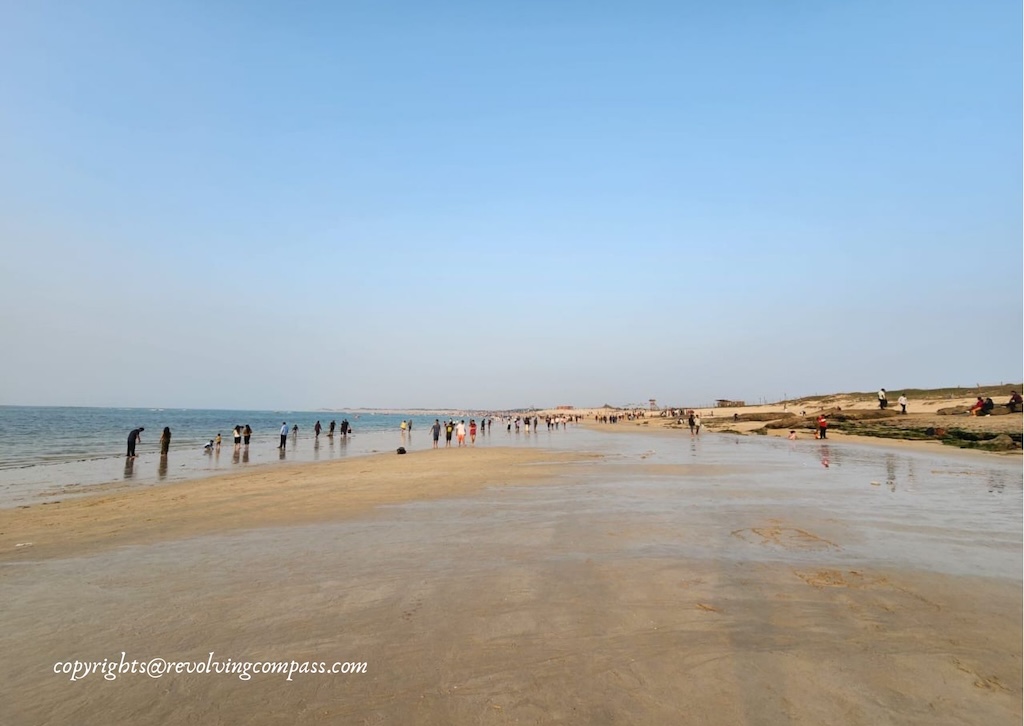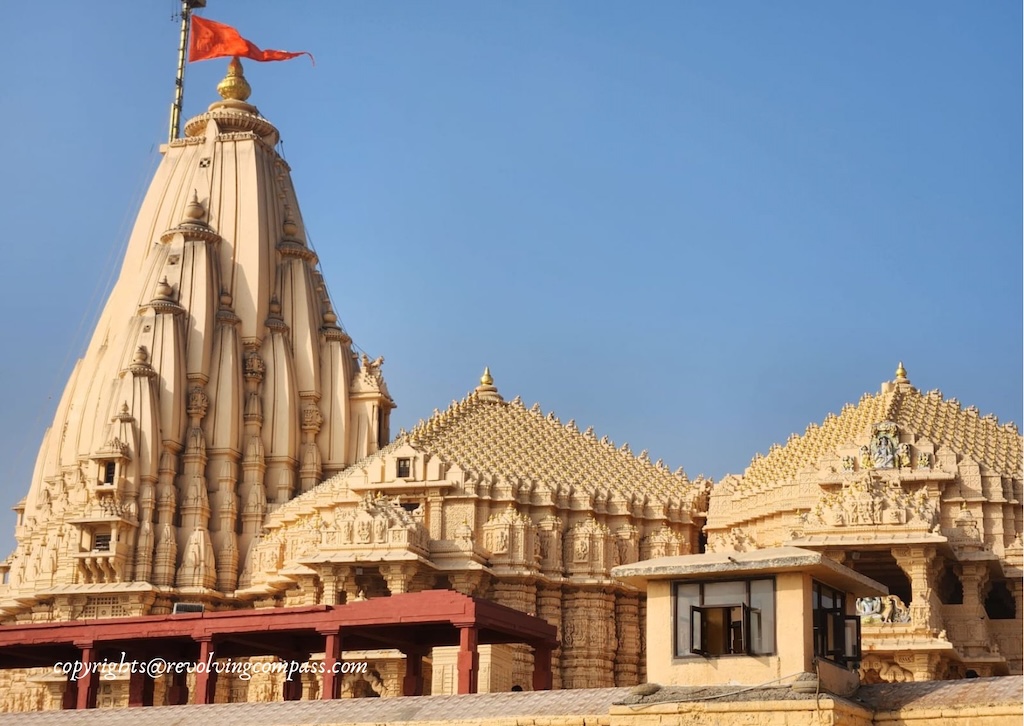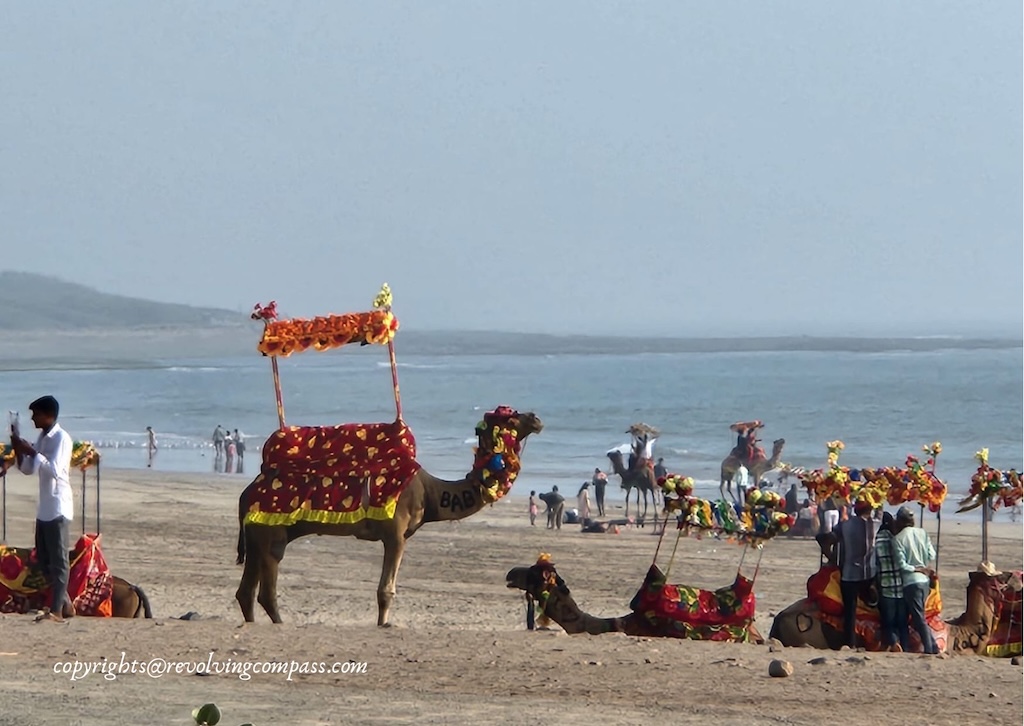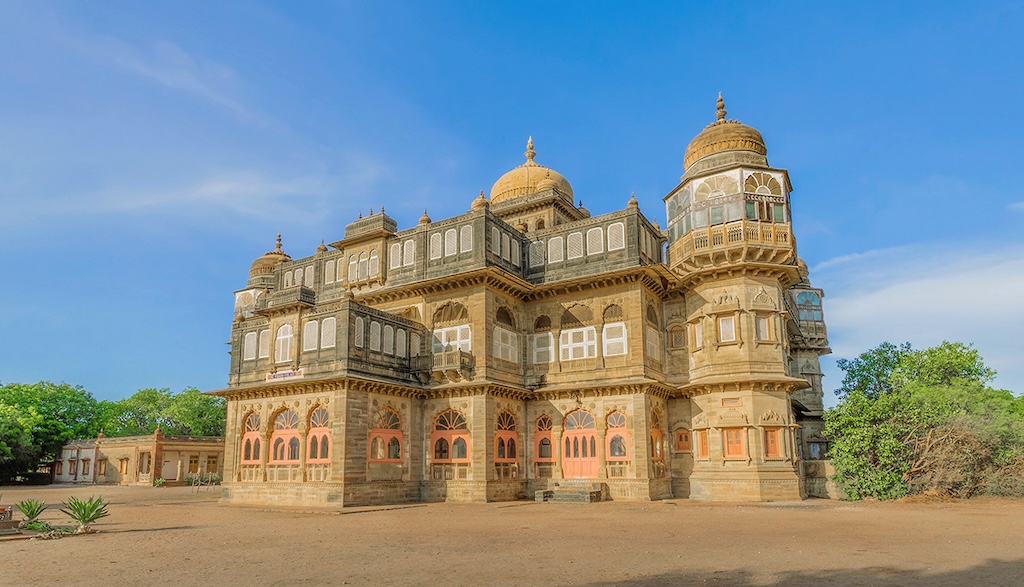On our 2 weeks trip to Gujarat, after experiencing a homestay hospitality in Kutch and exploring Kutch including the Rann Utsav, we proceeded along the coast of Gujarat. The sceneries changed once again. As salt manufacturing factories and palm trees replaced the barren lands of Kutch along the way.
Our first stop on the coastal Gujarat road trip was Dwarka. It takes around 8 hours to reach Dwarka from Kutch. The road condition was good overall except for a small stretch near Bhuj where highway widening is underway.
As it was almost evening time by the time we entered the city of Dwarka, we decided to proceed directly to Shivrajpur Beach.
Shivrajpur Beach – first stop on our coastal Gujarat road trip

Shivrajpur beach is one of the few blue flag beaches of India. It is a very neat and clean beach. With facilities like rest rooms and changing rooms present right on the beach.

The beach has an entry ticket of INR 30 per adult. entry for children is free at Shivrajpur Beach.
In the evening, the beach was abuzz with tourists and locals alike. People were taking a dip in the sea, walking along the coast, sitting on the rocks watching the waves. And even taking camel rides.

We spent the evening on Shivrajpur beach. Watching the sun set for a while and taking a walk along the beach.
We reached our hotel in Dwarka by 7:00pm. Took rest, had our dinner and then retired to our beds early. As we planned to visit the Dwarkadhish Temple the next day.
Dwarkadhish Temple visit
There is no ticket to book Dwarkadhish Temple.
Temple timing is from 6:30am to 1:00pm and 5:00pm to 9:00pm.
We started for the temple at around 6:00pm from our hotel. Luckily, the hotel was located just 800 metres from the temple. And it took us nearly 15 mins to reach the Dwarkadhish Temple.

Upon reaching the temple, we deposited our mobile phones and shoes at designated counters outside the temple. And got into the line of devotees outside the temple. Even at 7:00am in the morning, the line was long. It was a slow moving line. After sometime, the queues for male and female were divided.

We had our darshan around 8:30am. And after that we proceeded back to our hotel. On the way, we bought poori, chana and jalebi for our morning breakfast from one of the roadside outlets outside the temple.
About Dwarkadhish Temple, Dwarka
Dwarka Temple or Dwarkadhish Temple is one of the Char Dham pilgrimage sites — essential for Hindus to visit in their lifetime. Dedicated to Lord Krishna, who is worshiped here as the “King of Dwarka” (Dwarkadhish), the temple symbolizes Krishna’s earthly kingdom and his divine play (Leela).
The temple’s history dates back over 2,500 years, although the current structure was built in the 15th–16th centuries. Legend says that Krishna founded the city of Dwarka after leaving Mathura to establish a new kingdom. The temple’s five-story architecture, built from limestone and sand, features intricate carvings and a massive spire (Shikhara) topped with a flag that is changed several times a day.
Beyond religious devotion, the Dwarka Temple is significant because:
-
It connects deeply to the Mahabharata and Krishna’s life.
-
It showcases ancient Indian maritime and trade history.
-
Archaeological discoveries underwater near Dwarka suggest the possibility of a submerged ancient city, adding mystery and fascination.
-
It represents themes of dharma (righteousness), divine kingship, and devotion.
Pilgrims and travellers visit not just for blessings, but to experience a living legend, tied to one of the most beloved figures in Hinduism.
Upon reaching our hotel, we had the breakfast. And then we proceeded to checkout and continue our coastal Gujarat road trip.
Other places to visit in Dwarka
There are many other temples and places to visit in Dwarka. But if you have limited time, I highly recommend visiting Bet Dwarka – the home of Krishna, an island. And the Sudarshan Setu, the bridge that connects Dwarka to the island of Bet Dwarka.
PS: Places to visit in Dwarka in a day
Dwarka – Porbandar – Somnath road trip
From Dwarka, we started on a trip to Somnath via the Dwarka – Porbandar – Somnath highway. This whole highway runs along the coast of Gujarat. And is an excellent 4 lane highway. Although, we couldn’t halt in Porbandar due to time crunch. If you can, we highly recommend visiting these places in Porbandar –
- Kirti Mandir – a beautiful temple behind which stands the house of Mahatma Gandhi.
- Badra Hills Wildlife Sanctuary which is located just 15 km from Porbandar.
- Porbandar Beach
Finally we arrived at Somnath by 2:00pm. We first stopped for lunch before visiting the Somnath temple.
The Somnath Temple , Somnath, Gujarat

Around 3:00pm, we arrived at the Somnath Temple. Luckily, it was not at all crowded in the temple at this hour. We deposited our slippers and mobile phones. And then proceeded for the darshan.
About Somnath Temple Gujarat
The Somnath Temple is dedicated to Lord Shiva and is considered the first of the twelve Jyotirlingas, the sacred shrines where Shiva is believed to have manifested as a fiery column of light.
The temple’s significance is immense, spiritually and historically:
-
Spiritual Importance: It represents eternal faith and resilience. Devotees believe that Lord Shiva himself protects this place, and visiting Somnath is said to cleanse sins and lead to moksha (liberation).
-
Historical Symbol: Somnath has been destroyed and rebuilt several times throughout history — by invaders like Mahmud of Ghazni and later rebuilt by Hindu kings — symbolizing the indestructible spirit of Indian culture.
-
Architectural Beauty: The present structure, completed in 1951 under the guidance of Sardar Vallabhbhai Patel, reflects magnificent Chalukya-style architecture and stands proudly by the Arabian Sea.
-
Mythological Connection: According to legends, the Moon God (Chandra) built the original temple in gold to seek Lord Shiva’s blessings and regain his lost radiance, which gives the temple its name — ‘Somnath’ (Lord of the Moon).
-
Sacred Geography: The temple is uniquely positioned — it’s said that there’s no land between Somnath and the South Pole, making it a truly cosmic pilgrimage spot.
Thus, Somnath is not just a religious site; it is a symbol of devotion, perseverance, and renewal — embodying the spirit that even after countless destructions, faith and civilization rise again.

Somnath Beach, Gujarat
After visiting the Somnath Temple, we proceeded to Somnath Beach, located right behind the temple. There is a beautiful pathway constructed along the boundary of the Somnath Temple from outside. We walked along it, sat on the bench there to soak into the beauty. And then finally proceeded to the beach to spend sometime there.

Post this, we proceeded back. But not without checking the various shops along the way selling handicrafts and art work, shell and oxidised silver jewellery and much more. Somnath beach is definitely one of the most beautiful beach in Gujarat that I visited.

Overnight stay in Gir, Gujarat
Somnath is located at just 30km from Gir National Park, Gujarat. So, we had booked our accommodation at Gir Gujarat. After visiting the Somnath temple and beach on our coastal Gujarat road trip, we finally proceeded to our accommodation in Gir. We reached our resort around 5:30pm-6:00pm in the evening.

Overall it was a very satisfying day wherein we visited two very reverred temples of India. Spent time on one of the most beautiful beaches in Gujarat. And had a wonderful drive through the coastline of Gujarat.
Other stops to include in your coastal Gujarat road trip
If you have more time at hand, there are a couple of more beautiful places that you can include in your coastal Gujarat road trip. We highly wanted to include these but couldn’t due to time crunch. So, we have reserved them for the next time.
Mandavi Palace & Mandavi Beach
Mandavi is a port town at around 1 hour of driving distance from Bhuj Gujarat.
It is known for its rich history, serene beaches, and traditional shipbuilding. Founded in the late 16th century by Rao Khengarji I, Mandvi was once a major port city and a trading hub connecting India to East Africa, Arabia, and Europe.
Some highlights about Mandvi:
-
Mandvi Beach is famous for its clean sands, calm waters, and camel rides — a perfect blend of relaxation and fun.
-
Vijay Vilas Palace, a stunning royal residence, showcases Rajput architecture and has been featured in Bollywood films like Hum Dil De Chuke Sanam. It is definitely one of the most beautiful palaces in Gujarat and overall in India.
-
Traditional Shipbuilding is still alive here — craftsmen build beautiful wooden dhows (sailing ships) by hand, a tradition that’s centuries old.
-
The town also reflects Kutchi culture — from handicrafts to vibrant local markets.
-
Nearby, Wind Farms along the coast create a unique and scenic backdrop, showcasing Mandvi’s step into renewable energy.
Mandvi is special because it blends heritage, nature, and culture — offering a glimpse into Gujarat’s glorious past and its lively present.

Diu, Gujarat
Diu is a small, beautiful island town located on the southern coast of Gujarat, India. Though it is geographically close to Gujarat, it is part of the Union Territory of Dadra and Nagar Haveli and Daman and Diu. Diu is famous for its pristine beaches, Portuguese heritage, and peaceful vibe.
Historically, Diu was a Portuguese colony for over 450 years, until it became part of India in 1961. This colonial past is reflected in its stunning architecture — forts, churches, and old houses. Unlike most of Gujarat, where alcohol is banned, Diu allows it, making it a popular weekend getaway.

Highlights of Diu include
-
Natural Beauty: Long stretches of golden beaches like Nagoa Beach and Ghoghla Beach.
-
Historical Sites: Massive structures like the Diu Fort, beautiful old churches like St. Paul’s, and caves like the Naida Caves.
-
Culture: A unique blend of Gujarati traditions and Portuguese influence.
-
Relaxed Atmosphere: Less crowded, clean, and serene — perfect for relaxation.
Some of the places to visit in Diu that you can include in your coastal Gujarat road trip –
Places to visit in Diu, Gujarat
-
Diu Fort : A grand Portuguese fort from the 16th century, offering stunning views of the sea and the town.
-
Naida Caves : Beautiful, maze-like caves with natural rock formations — perfect for photography and a little adventure.
-
Nagoa Beach : The most popular beach in Diu — clean, calm, and great for swimming, relaxing, and water sports.
-
St. Paul’s Church : A masterpiece of baroque architecture, this white church is one of the best examples of Portuguese influence in India.
-
Gangeshwar Mahadev Temple : A peaceful seaside temple where five Shiva lingas are naturally washed by ocean waves.
-
INS Khukri Memorial : A touching tribute to the Indian Navy ship sunk during the 1971 war; a must-visit for history lovers.
-
Ghoghla Beach : A quiet and less crowded beach, ideal if you want a peaceful time by the sea.
-
Diu Museum (located inside St. Thomas Church) that showcases old statues, carvings, and artifacts that tell the story of Diu’s past.
-
Chakratirth Beach : A picturesque spot where myth says Lord Vishnu killed the demon Jalandhar.
-
Shell Museum : A unique and charming, it displays thousands of rare seashells collected over decades.

